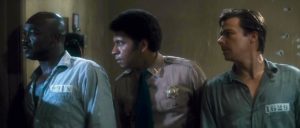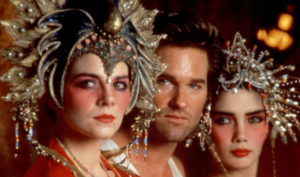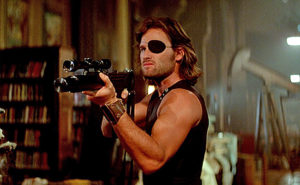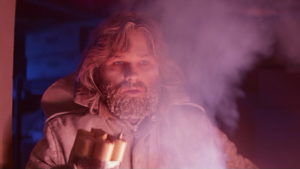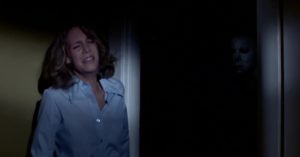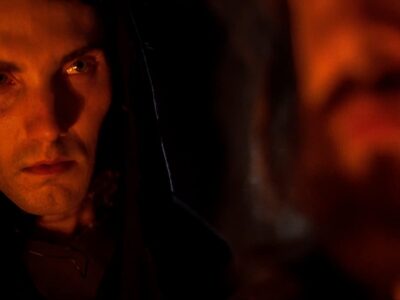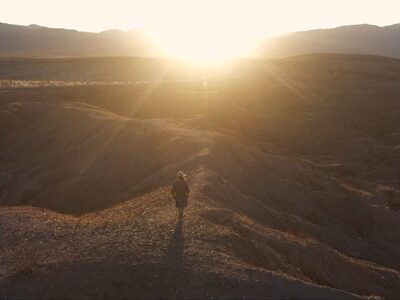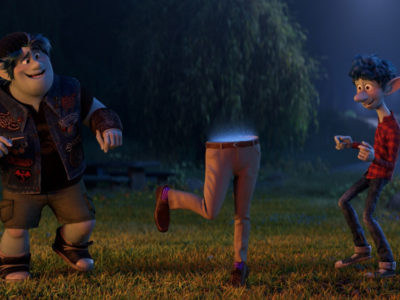Top 5 John Carpenter Movies
A month filled with celebrating the horror genre can only be fittingly celebrated with a look at one of its greatest directors. John Carpenter’s mixture of using empty space, glorious synth scores, and slow-building anticipation set him apart as a master of the horror genre and the inventor of the slasher sub-genre. Throw in gross practical effects and a penchant for controversy that would define some of his best movies, Carpenter was not only a master but an influential auteur who is more beloved now than he was in his heyday of filmmaking.
However, as a moderate fan only versed in Carpenter’s most well-known films, it seemed fitting to bring in a Carpenter nut and friend of Reel World Theology, Reed Lackey. Hosting The Fear of God podcast with co-host Nathan Rouse, Reed has been going through Carpenter’s filmography on their podcast during the month of October and discussing some of their favorite films. If you love horror at all or John Carpenter even a little, their podcasts on Carpenter are deep dives worth your time and iTunes reviews. You might even get a good rant or two on Suicide Squad at no extra charge!
All that being said, Reed and I have been working on a list of our favorite Carpenter movies. After some discussion, ranking, and disagreeing about Kurt Russell, we’ve come up with what we think are Carpenter’s five best films. Read on to see where they rank, let us know some of your favorite Carpenter movies, and make sure to tell us if you think we are dead wrong. I’ll personally collect your complaints and send them to Reed.
5) Assault on Precinct 13
Reed and I debated a little about this movie as to whether it should get the nod over a movie like Starman or even The Fog. And by debated I mean I said I love this movie and would fight him and he said Starman isn’t really quintessential Carpenter and Assault on Precinct 13 is. Being only the second feature-length film of Carpenter’s career, it came off the impressive debut of Dark Star, a student film turned into a feature-length movie. Assault feels like a 70’s genre movie but already has the 80’s feel to it with Carpenter’s first real great synth score and a subversive cast going against the typical stereotypes of female and African-American actors. Typically, The straight-laced, hero cop is played by a white guy who rescues everyone else and the minority characters essentially become cannon fodder for the bad guys, in this case the gangs of LA who have declared war on police for a recent slaughter of gang members by police. However, Carpenter casts 70’s TV and horror staple Austin Stoker, an African-American, as the lead and also the true brains and courage of the survivors stuck inside Precinct 13 is Leigh, played by relatively unknown actress Laurie Zimmer. The best recurring line/joke in the movie still goes to Darwin Joston’s Napoleon Wilson–“got a smoke?”–but the movie goes against convention and does so to not draw attention to it and therefore normalize it.
To say this movie is ahead of it’s time might be a bit cliche, especially since parts of the movie definitely fit the typical mold of a 70’s action movie. However, as the ten minute mark, the movie makes a strong case it may just be ahead of its time. In one of the only moments where a movie has made me audibly gasp in shock, a gang member in a senseless act of violence, shoots a little girl holding an ice cream cone. Carpenter plays up the suspense in the scene but you certainly don’t think such a shocking payoff will come, but when it does you are floored by its senseless nature. The movie was threatened with an X-rating for this scene, but Carpenter said he would cut it from the movie to the MPAA but then kept it in the movie anyway. While the scene certainly is shocking, it is a fitting motif to compel the action in a movie Carpenter has acknowledged was essentially a remake of Howard Hawks Westerns, only set in urban LA. It comes complete with a shootout, plenty of death, and clever, quick-fire dialogue on par with anything American audiences were familiar with from two decades prior. While the 2005 reboot was largely unsuccessful, this great type of thriller has found new life in director’s like Jeremy Saulnier, who’s movie Green Room was directly influenced by Assault, and Adam Wingard, who’s 2014 movie The Guest contained many of the same suspenseful, action-driven elements. ~Josh
4) Big Trouble In Little China
Given how bleak much of Carpenter’s work can be, Big Trouble in Little China can feel like a bit of an outlier in just how fun it is. The film opens with a sort of prologue where one character asks another (and by extension asks the audience), “Do you believe in magic?” What follows is a zany, kinetic, and utterly absurd fantasy adventure that deftly balances comedy, action, and suspense in nearly equal measure. It features gangs of ninjas, floating wizards, an indomitable hell-beast, and a villain whose head literally explodes. To say the least, it’s a little extreme.
3) Escape From New York
If there were a quintessential John Carpenter film — one that exhibited nearly all of the director’s trademarks and strengths — it might just be Escape from New York. Almost every thematic and directorial Element that runs through Carpenter’s filmography exists in escape from New York (except for, ironically, outright elements of horror). Envisioning a bleak future, where political and societal corruption have exiled lawbreakers as irredeemable waste, Carpenter drops the most compelling character in any of his films, Snake Plissken, into an oasis of anarchy.
The entire film feels like an indictment of The idolization of America. New York City, the geographical embodiment of American hopes and dreams, has regressed into a savage cesspool where criminals are contained like rats in an urban cage. Our hero is himself a criminal: a one-eyed, tough-guy everyman who is dependent on no one and answers to no one, making him a dark-sided version of the idealized American individual. And what task does our hero have to accomplish in this story? He has to enter the belly of the criminal beast and retrieve none other than the President of the United States, who has accidentally crashed into the midst of it.
Carpenter has always been a master social commentator, but rarely with so much blatant boldness as in Escape from New York. The film is suspenseful, often funny, with a razor’s edge hero and a notably low-budget feel. It shines a light on society’s underbelly and forced us to rethink even our own cherished iconography. Although he’s mostly known for horror, this action indie might just be the best representation of what he can do and say as a filmmaker. ~Reed
2) The Thing
Based on he short story Who goes There? and also the Howard Hawks-produced 1951 classic, The Thing From Another World, the movie plays with the ideas of the original source material but heightens the tension of survival of both the Arctic crew and the entire human race from annihilation by a terrifying monster. Unlike the original movie, Carpenter eschews a possible sympathetic arc for this alien monster and instead pits the crew of US Station #31 against the shadowy being and against one another. Unlike the original, which plays on post-World War II fears of a new, global enemy and tells the audience to “keep watching the skies” for this otherworldly threat, Carpenter takes a more existential and inward approach to the material by positing the enemy lies within us all. While the 1951 movie does play with this motif, it is essential to Carpenter’s narrative and cinematic artistry in building tension around who is the true enemy and who can be trusted. It’s a swipe at American fears both past and present, and it’s ending can either be seen as a nihilistic throwing up of hands at the fragility and brokenness of humanity or if “seeing what happens” is a hopeful utterance of a better future after living through a nightmarish hell.
Despite Reed’s claim of Escape From New York being Carpenter’s most “Carpenter-esque” film, I believe his 1982 Sci-Fi/Horror movie is the most “John Carpenter-esque” of his entire filmography both because of how it was received and how it is the most pure distillation of every single artistic distinctive Carpenter possesses. Originally detested by critics and famously called a “barf-bag movie” by Roger Ebert, the movie has undergone a reassessment and is now appreciated as a cinematic classic and one of the better horror and Sci-Fi movies of the 1980’s. It is full of Carpenter’s signatures; usage of empty space to build tension, state-of-the-art and seriously gross special effects to invoke stomach-churning terror, and also Kurt Russell. Russell’s character, as he does in Escape From New York, is a no-nonsense tough guy who takes risks, uses his head, and is committed to eradicating the threat laid in front of him. Russell embodies the best of Carpenter’s characters, and would only be outmatched by an equally resilient and resourceful heroine in his greatest and most influential movie, which is #1 on our list. ~Josh
1) Halloween
Capitalizing on the sub-textual consequences of sin while unleashing an iconic boogeyman into the typical safety of small town suburbia, John Carpenter crafted a film that is two-sentence simple in its premise, but rich and complex in its themes and allusions. Halloween was, for a long time, the most successful independent film in cinema history. It legitimized the slasher genre as a market commodity, established the film legacy of John Carpenter, and remains nearly every bit as scary almost forty years later. It is, in many ways, a textbook horror film (though it could be argued that it largely wrote that textbook), containing an abundance of sudden shrieks of music, an ominous figure lurking in the distance, and — of course — a whole mess of hacking and slashing.
But it is also a distinctly American film, in that it upends the security and pleasantries of the suburban middle-class lifestyle and reeks havoc on a quaint suburban neighborhood. It also under-girds its narrative beats with the threat of consequences for immoral behavior (playing off of traditional “American” values), and it takes place on that uniquely Americana night known as Halloween. The film remains the landmark of Carpenter’s career, but it also largely remains the benchmark for that specific subset of American horror known as the urban legend, where bogeymen hide behind bushes and creep into the safe spaces of those who have transgressed to service their proper penance. In nearly every way, literally and metaphorically, Carpenter brought Michael Myers — and the modern urban legend — home with the best film of his career — Halloween. ~Reed


